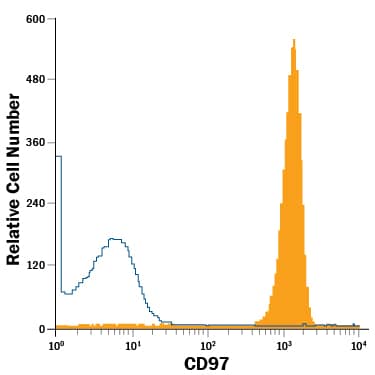Human CD97 APC-conjugated Antibody
R&D Systems, part of Bio-Techne | Catalog # FAB2529A


Key Product Details
Species Reactivity
Validated:
Cited:
Applications
Validated:
Cited:
Label
Antibody Source
Product Specifications
Immunogen
Gln21-Gln398
Accession # NP_001775.2
Specificity
Clonality
Host
Isotype
Scientific Data Images for Human CD97 APC-conjugated Antibody
Detection of CD97 in Human Neutrophils by Flow Cytometry.
Human neutrophils were stained with Mouse Anti-Human CD97 APC-conjugated Monoclonal Antibody (Catalog # FAB2529A, filled histogram) or isotype control antibody (Catalog # IC003A, open histogram). View our protocol for Staining Membrane-associated Proteins.Applications for Human CD97 APC-conjugated Antibody
Flow Cytometry
Sample: Human neutrophils
Formulation, Preparation, and Storage
Purification
Formulation
Shipping
Stability & Storage
Background: CD97
CD97 is a 95‑100 kDa member of a protein group known as the LNB-TM7 protein family that evolved from genes of the secretin receptor superfamily (1‑3). Molecules in this family are unique hybrid structures consisting of EGF-like modules coupled to class B G-protein 7-transmembrane (TM) domains by a glycosylated (mucin) stalk. Human CD97 is synthesized as an 835 amino acid (aa) precursor that contains a 20 aa signal sequence, a 532 aa extracellular domain (ECD), a 238 aa “transmembrane” region that includes seven TM segments, and a 45 aa cytoplasmic tail (4). Within the 532 aa ECD, the first 236 aa contains five EGF-like domains, the C-terminal four of which bind calcium, and a juxtamembrane 296 aa RGD-containing mucin stalk (4, 5). The stalk is both glycosylated and proteolytically cleaved (at aa 530) to create a noncovalently linked 65‑70 kDa glycosylated extracellular alpha-subunit and a 28 kDa 7-TM membrane-bound beta-subunit (4). There are two known alternate splice forms in human. Isoform # 1 contains four EGF-like domains (domain # 1, 2, 3 and 5), while isoform # 2 contains three EGF-like domains (domain # 1, 2 and 5) (1, 4, 6). The ECD in isoform 1 is 60 kDa in size, while the ECD in isoform 2 is 55 kDa in size (native molecular weight). The five EGF-like domain region in human is 55% aa identical to that in mouse. Cells known to express CD97 include monocytes, macrophages, T cells, select B cells, dendritic cells and, potentially, vascular and visceral smooth muscle cells (1, 7). There are at least two ligands for CD97. One is chrondroitin sulfate that binds only to the full-length (five domain) form of CD97. Binding is dependent on the presence of EGF-like domain # 4 (3). The second ligand for CD97 is CD55, a GPI-linked cell surface molecule with short consensus repeats that regulates complement activation on cell surfaces (1, 5, 7). CD97 EGF-like domains # 1 and 2 bind CD55 while domain # 5 stabilizes the CD97 molecule. The shortest CD97 isoform shows the strongest binding to CD55 (7, 8).
References
- McKnight, A.J. and S. Gordon (1998) J. Leukoc. Biol. 63:271.
- Stacey, M. et al. (2000) Trends Biochem. Sci. 25:284.
- Stacey, M. et al. (2003) Blood 102:2916.
- Gray, J.X. et al. (1996) J. Immunol. 157:5438.
- Lin, H-H. et al. (2001) J. Biol. Chem. 276:24160.
- Hamann, J. et al. (1995) J. Immunol. 155:1942.
- Jaspars, L.H. et al. (2001) Tissue Antigens 57:325.
- Hamann, J. et al. (1996) J. Exp. Med. 184:1185.
Alternate Names
Gene Symbol
UniProt
Additional CD97 Products
Product Documents for Human CD97 APC-conjugated Antibody
Product Specific Notices for Human CD97 APC-conjugated Antibody
For research use only